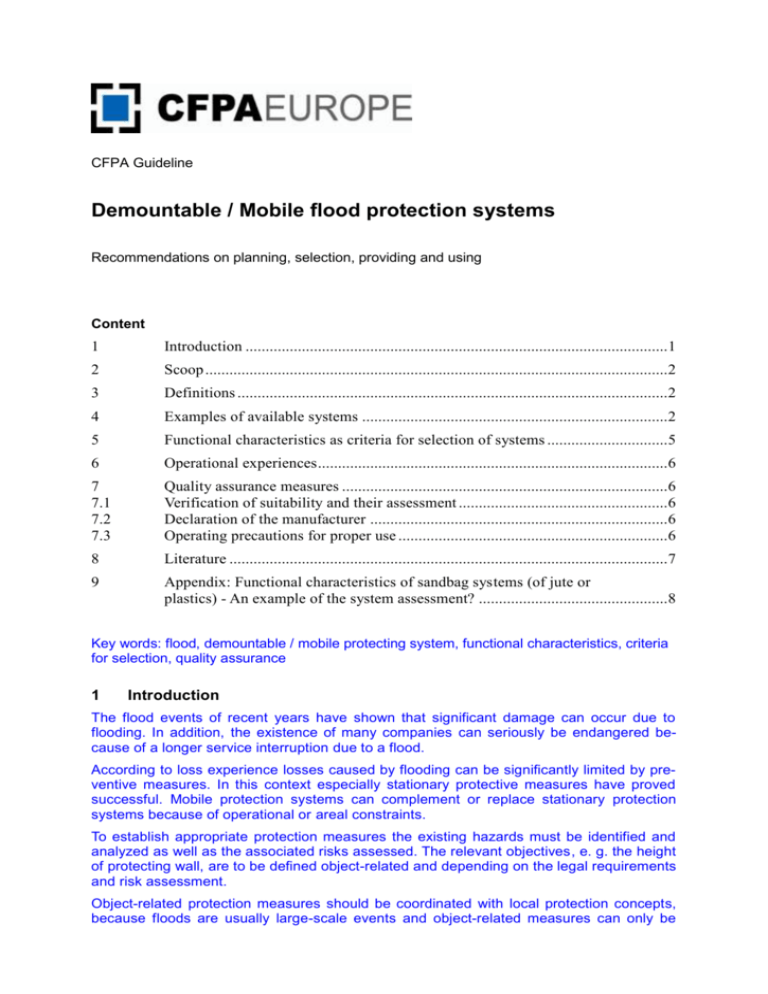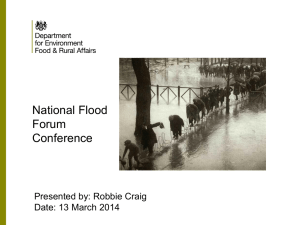Proposal_DemountableProtectionSystems
advertisement

CFPA Guideline Demountable / Mobile flood protection systems Recommendations on planning, selection, providing and using Content 1 Introduction ......................................................................................................... 1 2 Scoop ...................................................................................................................2 3 Definitions ........................................................................................................... 2 4 Examples of available systems ............................................................................ 2 5 Functional characteristics as criteria for selection of systems .............................. 5 6 Operational experiences .......................................................................................6 7 7.1 7.2 7.3 Quality assurance measures ................................................................................. 6 Verification of suitability and their assessment ....................................................6 Declaration of the manufacturer .......................................................................... 6 Operating precautions for proper use ................................................................... 6 8 Literature ............................................................................................................. 7 9 Appendix: Functional characteristics of sandbag systems (of jute or plastics) - An example of the system assessment? ............................................... 8 Key words: flood, demountable / mobile protecting system, functional characteristics, criteria for selection, quality assurance 1 Introduction The flood events of recent years have shown that significant damage can occur due to flooding. In addition, the existence of many companies can seriously be endangered because of a longer service interruption due to a flood. According to loss experience losses caused by flooding can be significantly limited by preventive measures. In this context especially stationary protective measures have proved successful. Mobile protection systems can complement or replace stationary protection systems because of operational or areal constraints. To establish appropriate protection measures the existing hazards must be identified and analyzed as well as the associated risks assessed. The relevant objectives, e. g. the height of protecting wall, are to be defined object-related and depending on the legal requirements and risk assessment. Object-related protection measures should be coordinated with local protection concepts, because floods are usually large-scale events and object-related measures can only be effective if they are embedded in the local protection concepts. In addition, potential threats to the stability of buildings by buoyancy or penetrating groundwater are to be considered in the risks assessed. …? 2 Scoop The present guideline covers the planning, selection, providing and using of mobile flood protection systems. Mobile flood protection systems are currently widely available on the market. The aptitude test of these systems is, however, still according to different criteria and by various methods. For this reason, notes and typical criteria for selection of suitable mobile flood protection systems are systematically prepared as recommendations, in order to support the decision-makers, planners and managers of flood protection to take appropriate measures in practice. This publication is based on the current knowledge and previous experience of loss prevention and risk management. It will be reviewed regularly and updated when there are significant improvements resulted in the specified fields. Legal regulations are not affected. …? 3 Definitions Stationary flood protection systems: structural protective measures that are largely ready without foreign action and so ensure their full protective effect permanently Mobile flood protection systems can be divided simplified as follows: − Scheduled systems that are transported and assembled in case of application to the site. The installation of these systems requires physical provision on-site. − Standard emergency systems that are marketed and assembled without physical provision on-site. Stationary systems with movable elements, which are activated in case of application can be assigned to mobile systems. …? 4 Examples of available systems Mobile flood protection systems can be designed and used both for the protection of areas as well as for the protection of individual objects, e. g. fitted in building openings (doors, gates, driveways). Following typical mobile flood protection systems are listed without any claim to completeness. − Hydroplaning systems − Stop log systems − Folding systems (possibly with impact protection) − Sandbag systems − Container systems (filled with water or sand) − Bock systems − Hose systems (filled with water, sand or air) − Other systems Precast concrete elements, … …? 5 Functional characteristics as criteria for selection of systems Apart from the costs for acquisition and operation mobile flood protection systems differ among others, with respect to the structure, permissible application areas and the need and expense for the logistics and maintenance. Simplified, these functional characteristics as evaluation criteria are divided into the following topics − Type of System − Scope of application: Applications or system limitations according to the testing and approval, e. g. maximum water level − Material: Susceptibility to frost, resistance to salt water and UV − Statics: Integrity and load capacity, stability (resistance against flotsam or mechanical effects, susceptibility to vandalism, …) − Tightness; Test methods and allowable leakage, compensate for uneven surfaces and soil bearing capacity, … − Costs (Reference base L x H = 100 m x 1 m): life, reuse or disposal, necessary structural conditions and additional costs for these − Operation expense (Reference base L x H = 100 m x 1 m): time, devices, people and manual and training for installation − Expenses for maintenance after use: needed time, devices and number of people − Expense for periodic maintenance: Time, devices, number of people and other, e. g. additional measures to protect against feeding animals − Logistics: weight of typical individual elements, maximum dimensions of the standard system, necessary capacity required for storage (e. g. per 100 m), storage outdoor or protected indoor, necessary transport capacity − References (e. g. practical assignments and also in the sense of the product liability protection. …? 6 Operational experiences The preparation and explanation of the functional characteristics as criteria for selection have clearly shown that the use of mobile flood protection systems should be practiced regularly, because the participating institutions and emergency forces must be attuned to each other, despite an in-depth planning. The timely and proper set up of the mobile protection systems therefore presupposes ahead, inter alia, the following − The application site, e. g. the access road is shut off over a wider area as possible and clearly visible properly signposted. A shutting off single lanes has shown insufficient − … …? 7 Quality assurance measures The protective functions of mobile flood protection systems in case of use will be determined significantly by the properties of the systems on the one hand and on correct assembly on the other hand. …? 7.1 Verification of suitability and their assessment The required characteristics of mobile flood protection systems, such as the stability and tightness depending on the water pressure and resistance to mechanical impacts, must – like with all other security related products – always be proved by the tests of prototypes according to approved methods and procedures. …? 7.2 Declaration of the manufacturer Mobile flood protection systems can have different properties with respect to the area and object protection. To support the choice of appropriate protection systems for local conditions in practice manufacturers should provide the all functional characteristics as information for the user. …? 7.3 Operating precautions for proper use For the use of mobile flood protection systems sustainable maintenance of the components and a solid operational and logistics planning are always required. The emergency response plan must contain reporting chains, required warning and mobilization times and define of necessary personnel, e. g. for set up, and transportation capacity. As far as interfaces consist of flood protection measures in the public sector, it must be ensured that effects of changes in public area are recognized and taken into account to the object-related protection system. This can be, for example, hydraulic engineering measures on waters (including dams, bridges, and retention areas), changes in the neighborhood in terms of surface drainage and development or changes to flood control measures in public ownership. …? 8 Literature Gesamtverband der Deutschen Versicherungswirtschaft e. V. / Hochwasser-KompetenzCentrum "Mobile Hochwasserschutzsysteme; Hinweise für die Beschaffung, den Einsatz und die Bereitstellung " (VdS 6001) http://vds.de/fileadmin/vds_publikationen/vds_6001_web.pdf … 9 Appendix: Functional characteristics of sandbag systems (of jute or plastics) - An example of the system assessment?







